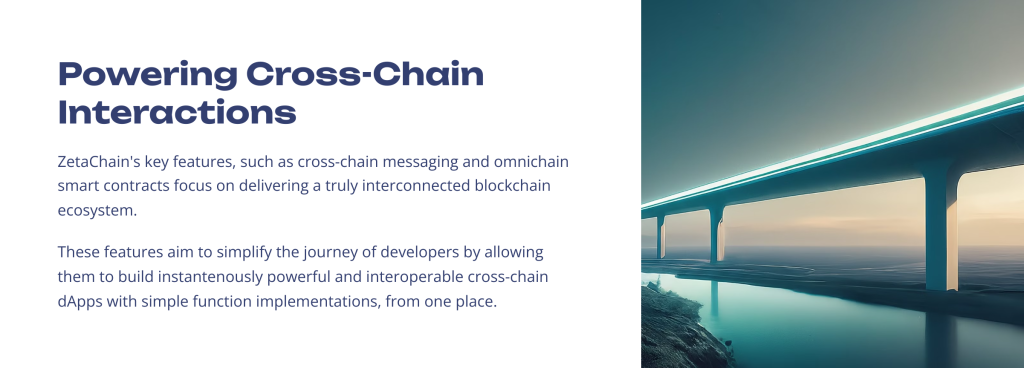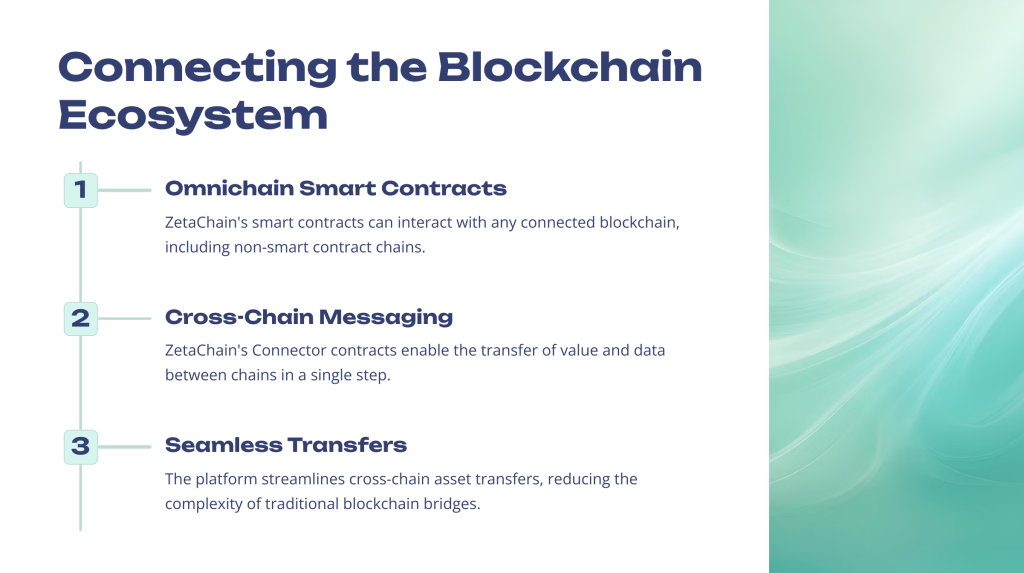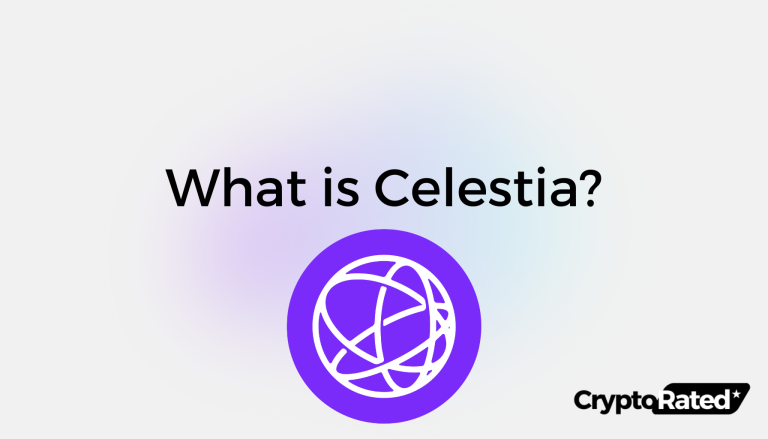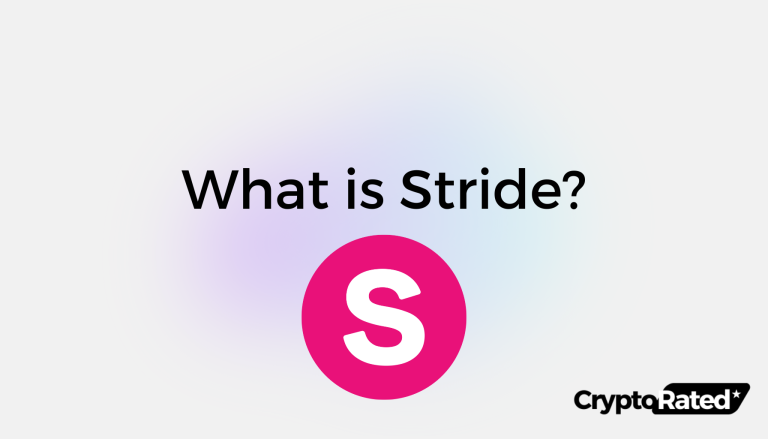
ZetaChain is a unique Layer 1 blockchain that facilitates seamless interoperability between different blockchain networks. With its innovative approach, it is compatible with both smart contract platforms and non-smart contract chains, such as Bitcoin and Dogecoin. It achieves interoperability through its omnichain smart contracts and the ZetaEVM virtual machine, which have been instrumental in fostering an interconnected blockchain space since ZetaChain’s 2024 launch.
Powering ZetaChain, the native ZETA token acts both as a governance and utility token within the network. With an initial max supply set at 2.1 billion tokens and an annual inflation rate of 2.5% after the first four years, ZETA’s tokenomics are designed to incentivize ecosystem growth without excessive coin emissions.

Key Takeaways
- ZetaChain introduces seamless blockchain interoperability, including those with and without native smart contract support.
- With an initial max supply of 2.1 billion, the ZETA token plays a key role in the ecosystem, with its use cases ranging from community governance to gas fee payments and validator incentives.
- Sound tokenomics and the strategic distribution of ZETA foster the long-term sustainability and stability of the ZetaChain ecosystem.
What Is ZetaChain (ZETA)?
Launched in 2024, ZetaChain is a Layer 1 interoperability blockchain that makes generic, omnichain smart contracts and messaging possible between any chain. With the mission to open the global crypto market to anyone, the project provides the foundation for a truly fluid cryptocurrency ecosystem that allows users and developers to move between different networks without hassle.
While ZetaChain supports smart contract blockchains, its omnichain smart contracts can introduce programmability to non-smart contract chains like Bitcoin and Dogecoin. Simultaneously, the Ethereum-compatible ZetaEVM (zEVM) virtual machine is built on top of the mainnet to deploy and use omnichain smart contracts, orchestrating any digital asset on any external chain through Zeta’s interoperability layer.
| ZetaChain | LayerZero | Token Bridges | Cosmos | |
| DEX | Yes | Yes | No | Yes |
| Value Transfer | Yes | Yes | Yes | Yes |
| Chain-Agnostic | Yes | Smart contract blockchains | App-specific blockchain pairs | IBC required |
| Native Bitcoin Vault Management | Yes | No | App-specific blockchain pairs | No |
| Settlement | Immediate native settlement | Wrapped or immediate | Wrapped (redemption-related risks) | Wrapped |
| Omnichain Smart Contracts | Yes | No smart contracts | App-specific blockchain pairs | IBC required |
| Message Passing | Yes | Yes | No | IBC required |
ZETA, the platform’s native token, serves multiple use cases – from governance to settling gas fees and fostering ecosystem growth. Securing $27 million from investors, ZetaChain seeks to become a key interoperability blockchain in the market, establishing a foundation for developers to build powerful cross-chain decentralized applications (dApps) with simple function implementations through cross-chain message passing.
How Does ZetaChain Work?

As part of a Layer 1 blockchain, ZetaChain was built on the Cosmos SDK and uses the Proof-of-Stake (PoS) Tendermint consensus mechanism. Its architecture takes blockchain interoperability to the next level with the following key components and features:
- Cross-Chain Messaging: ZetaChain’s smart contracts on any connected blockchain can transfer value and data to other contracts located on other chains via the project’s Connector contracts in a single step.
- Omnichain Smart Contracts: Utilizing ZetaChain’s Ethereum-compatible ZetaEVM virtual machine with the ZRC-20 token standard and omnichain smart contracts working across various blockchains, ZetaChain empowers users and developers with the ability to access and manage assets, liquidity, and data on any blockchain from a single platform.
- Seamless Cross-Chain Transfers: The platform streamlines how assets are moved across different blockchains, significantly reducing the complexity typically associated with bridges. ZetaChain even connects chains without native smart contract support.
- Managed External Access: Due to ZetaChain’s architecture and interoperability, dApps built on top of the Layer 1 blockchain can manage vaults and assets on externally connected chains, introducing smart contract logic to any connected network.

ZetaChain’s powerful blockchain interoperability offers a seamless cross-chain experience without the technical complexities and potential security vulnerabilities of traditional bridges.
ZETA Token 101: Utility and Use Cases
ZETA tokens serve a wide range of use cases within the ZetaChain ecosystem. Functioning as both a utility and a governance token, it facilitates the decentralized operation of the blockchain and powers cross-chain interactions.
In the ZetaChain ecosystem, ZETA fulfills the following utilities:
- Validator Incentives: Validators and their delegators receive ZETA emissions as rewards for producing blocks and verifying transactions.
- Gas Fee Payments: ZETA serves as gas for the Layer 1 blockchain’s omnichain smart contract layer and internal transactions, similar to the role of ETH in the Ethereum network.
- Cross-Chain Interactions: During cross-chain messages, the interoperability blockchain burns ZETA tokens on the source and mints them on the destination chain to facilitate value transfers between interconnected chains without creating new wrapped assets.
- Liquidity Pools: To enable cross-chain transactions between ZetaChain and other connected blockchains via the omnichain interoperability platform, ZETA and other external chain assets are used to operate Core Liquidity Pools and incentivize liquidity provider (LP) activity.
- Community Governance: ZETA holders can participate in ZetaChain’s community governance mechanism and shape the future of the ecosystem together with other users.
The Distribution and Tokenomics of ZETA Tokens
At launch, ZETA tokens were initially issued at a supply of 2.1 billion, with a target annual inflation rate of around 2.5% after the fourth year. With the goal to promote long-term sustainability via a stable ecosystem, ZETA’s token distribution looks like below:
- User Growth Pool (10%): A part of the tokens is set aside to attract new users via community incentives such as airdrops.
- Ecosystem Growth Fund (12%): These tokens incentivize ecosystem growth, aiding both ZetaChain partners and dApp developers.
- Validator Incentives (10%): Rewards are distributed to validators in exchange for helping secure the ecosystem.
- Liquidity Incentives (5.5%): 5.5% of the tokens are dedicated to incentivizing liquidity in pools like ZRC-20 token pools to facilitate seamless transaction experiences.
- Protocol Treasury (24%): Dedicated to financing ongoing operations, protocol development, and initiatives to improve the ecosystem.
- Core Contributors (22.5%): 22.5% of the ZETA supply are distributed to core contributors.
- Early Purchasers (16%): Finally, 16% of the tokens is allocated to early purchasers.
Through this strategic token distribution of ZETA, ZetaChain aims to lay down the foundations of a thriving and sustainable ecosystem.
Final Thoughts
ZetaChain is a Layer 1 blockchain that takes cross-chain interoperability with the next level through features and components like zEVM, omnichain smart contracts, and cross-chain messaging. Besides chains with native smart contract functionality, it can even connect non-smart contract blockchains. Simultaneously, dApps deployed on ZetaChain can manage assets and vaults across externally connected networks from a single place.
With these powerful features, ZetaChain seeks to create a more interconnected blockchain ecosystem that offers seamless cross-chain interactions for users and developers, significantly minimizing the complexities of such transfers and reducing the fragmentation of the market.
Frequently Asked Questions (FAQ)
How do cross-chain swaps work on ZetaChain?
ZetaChain enables seamless cross-chain swaps between ZetaChain and connected blockchain networks through the combination of cross-chain messaging, its ZetaEVM virtual machine, and omnichain smart contracts.
Are there ongoing investments in ZetaChain’s development?
To date, ZetaChain has raised $27 million of funds from investors to foster the development of the omnichain interoperability blockchain.
What is ZetaChain’s approach to Layer 1 blockchain interoperability?
ZetaChain offers an innovative approach to interoperability among Layer 1 blockchains, which enables its users and developers to move value and data between Zeta and externally connected networks. ZetaChain utilizes several components to interconnect chains, including omnichain smart contracts, the Ethereum-compatible ZetaEVM virtual machine, and cross-chain message passing.
WRITTEN
Benjamin Vitaris
Seasoned crypto, DeFi, NFT and overall web3 content writer with 9+ years of experience. Published in Forbes, Entrepreneur, VentureBeat, IBTimes, CoinTelegraph and Hackernoon.




